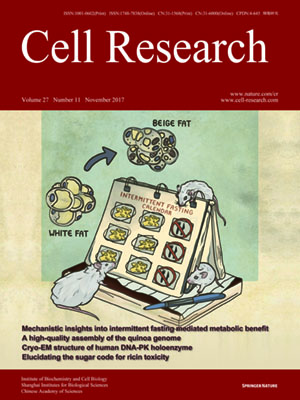
Volume 27, No 11, Nov 2017
ISSN: 1001-0602
EISSN: 1748-7838 2018
impact factor 17.848*
(Clarivate Analytics, 2019)
Volume 27 Issue 11, November 2017: 1327-1340 | Open Access
ORIGINAL ARTICLES
A high-quality genome assembly of quinoa provides insights into the molecular basis of salt bladder-based salinity tolerance and the exceptional nutritional value
Changsong Zou1, Aojun Chen1, Lihong Xiao1, Heike M Muller2, Peter Ache2, Georg Haberer3, Meiling Zhang1, Wei Jia1, Ping Deng1, Ru Huang1, Daniel Lang3, Feng Li1, Dongliang Zhan4, Xiangyun Wu5, Hui Zhang6, Jennifer Bohm7, Renyi Liu1, Sergey Shabala7, Rainer Hedrich2, Jian-Kang Zhu1,8 and Heng Zhang1
1Shanghai Center for Plant Stress Biology, CAS Center for Excellence in Molecular Plant Sciences, 3888 Chenhua Rd, Shanghai 201602, China;
2Julius-von-Sachs-Institut für Biowissenschaften, Biozentrum, University of Würzburg, D-97082 Würzburg, Germany;
3Plant Genome and Systems Biology, Helmholtz Center Munich, D-85764 Neuherberg, Germany;
41gene Corporation, 88 Jucai Road, Hangzhou, Zhejiang 310050, China;
5Shanxi Jiaqi Quinoa Development Co. Ltd., Quinoa Industrial Park, Pinglu District, Shuozhou, Shanxi 038600, China;
6Key Laboratory of Plant Stress Research, Shandong Normal University, No. 88 Wenhua East Rd, Jinan, Shandong 250014, China;
7School of Land and Food, University of Tasmania, Hobart, TAS 7001, Australia;
8Department of Horticulture and Landscape Architecture, Purdue University, West Lafayette, IN 47907, USA
Correspondence: Heng Zhang, E-mail: zhangheng@sibs.ac.cn; Jian-Kang Zhu, E-mail: jkzhu@sibs.ac.cn; Rainer Hedrich, E-mail:(hedrich@botanik.uni-wuerzburg.de)
Chenopodium quinoa is a halophytic pseudocereal crop that is being cultivated in an ever-growing number of countries. Because quinoa is highly resistant to multiple abiotic stresses and its seed has a better nutritional value than any other major cereals, it is regarded as a future crop to ensure global food security. We generated a high-quality genome draft using an inbred line of the quinoa cultivar Real. The quinoa genome experienced one recent genome duplication about 4.3 million years ago, likely reflecting the genome fusion of two Chenopodium parents, in addition to the γ paleohexaploidization reported for most eudicots. The genome is highly repetitive (64.5% repeat content) and contains 54 438 protein-coding genes and 192 microRNA genes, with more than 99.3% having orthologous genes from glycophylic species. Stress tolerance in quinoa is associated with the expansion of genes involved in ion and nutrient transport, ABA homeostasis and signaling, and enhanced basal-level ABA responses. Epidermal salt bladder cells exhibit similar characteristics as trichomes, with a significantly higher expression of genes related to energy import and ABA biosynthesis compared with the leaf lamina. The quinoa genome sequence provides insights into its exceptional nutritional value and the evolution of halophytes, enabling the identification of genes involved in salinity tolerance, and providing the basis for molecular breeding in quinoa.
10.1038/cr.2017.124
FULL TEXT | PDF
Browse 1963


